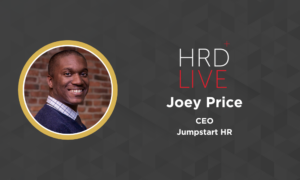Closing the HR-to-CEO gap: unlocking HR’S potential to enhance strategic impact
- 7 Min Read
Exploring transformative approaches for HR to bridge its divide with CEOs, amplifying its strategic influence in organizational decision-making
- Author: Sergio Pieterse
- Date published: Sep 21, 2023
- Categories

The last few years have seen a stream of problems for HR: the challenges of the pandemic, widespread quitting and layoffs, a move to hybrid work and a recent nine-year high for employee disengagement.
The truth is that two-thirds of senior HR leaders think their organization is struggling to keep up with changing workplace challenges like these. Nearly 70% are worried about engaging hybrid or remote workers. Additionally, two-thirds are concerned about providing four-day work weeks, while 65% say their influence upon the C-suite is only strong when there is an urgent or short-term problem.
As the lines between operational and strategic HR continue to blur, HR leaders are facing challenges in prioritizing the strategic aspects of their roles. They are increasingly required to be involved in day-to-day activities to ensure the business goals are met. Consequently, many HR leaders find themselves lacking empowerment, primarily due to their predominantly operational focus.
How do you break the cycle of being an operational-focused HR function and empower HR leaders to contribute strategically to the organization’s goals? How can HR leaders have a strong, ongoing influence in the C-suite, and ensure that HR’s voice is consistently heard and valued in strategic decision-making processes?
On Tuesday, 5th September 2023, HRD Connect hosted a group of senior HR leaders to discuss transitioning into a more strategic role to amplify HR’s impact in a roundtable. The discussion was led by Jagrity Singh, Group Talent Director at Smiths Group and supported by Rebecca McGuire, Learning Experience Lead at Personio. The virtual session was conducted under Chatham House rules so while this write-up will highlight key discussion points and takeaways, all participants are anonymized.
Adapting to a changing world
The discussion began by acknowledging constantly changing world dynamics. Participants highlighted the impact of recent global events, which initially led to layoffs in many organizations, followed by the challenges of remote and hybrid working. Singh noted that employee disengagement is at its highest point in nine years. She emphasized the need to understand the causes of this disengagement and find ways to influence and address it.
One participant mentioned how their company experienced a significant cultural shift when a CEO from another country joined, highlighting the challenges that can come with leadership changes. Another participant added how their CEO’s perspective on bringing employees back to work full time was a point of contention for some in the organization, affecting engagement and retention. Overall, most agreed that offering hybrid working is no longer an option but an expectation. This allows organizations to access a wider talent pool and attract talent.
Using the Marie Kondo method on tasks
A few participants lamented the challenge of balancing operational and strategic aspects of their roles. One participant felt that their day-to-day tasks can often dominate the workload, leaving limited time for strategic thinking and planning. Another participant suggested that achieving a balance between operational and strategic tasks requires intentional time allocation. They emphasized that strategic work takes more time, thinking and space. Therefore, HR professionals need to allocate their time accordingly.
McGuire shared a creative approach to decluttering operational tasks and processes within her team, akin to the Marie Kondo method for decluttering personal belongings. This involved assessing the value and efficiency of tasks and processes to free up time for strategic work. Everyone agreed that a shifting mindset is essential to being more strategic.
Asserting your seat at the executive table
The conversation around the transition of HR into a more strategic position continued, with a participant expressing the desire to have a greater influence on the direction of their organization and ensure their input is considered.
Another participant highlighted the importance of expecting a seat at the decision-making table. Being proactive and assertive in seeking involvement in key decisions can help HR professionals be more confident in their roles and the importance of HR in organizations. The consensus was that to be strategic, HR professionals should actively listen to colleagues and leadership to understand their priorities and concerns. Aligning HR strategy with the broader organizational goals is crucial.
Assessing tomorrow’s challenges together
Singh noted that HR leaders need to prepare their teams for the future. This involves coaching and developing team members to think strategically and proactively. Identifying team members’ interests and encouraging them to lead in areas they are passionate about can help drive strategic thinking. A participant added that in their team, encouraging members to challenge the status quo and provide insights into what can be done better is vital. Thus, collaboration within the HR team can lead to a stronger collective effort and a more strategic approach.
One panellist re-emphasized the importance of encouraging zeal among team members. Again, by identifying individuals’ passions within the HR team, HR leaders can harness their enthusiasm and motivate them to take a more active role in shaping the organization’s future. Additionally, fostering a culture of creativity before capital, where innovative solutions are prioritized, can lead to quick wins and enhanced engagement.
Data-driven decision-making and capturing the voice of employees were furthermore identified as important elements of future-readiness. These factors can inform HR strategies and ensure they align with employee needs and organizational goals.
Case study for HR and CEO alignment
Singh brought up an HR study by Personio to address the challenges of aligning HR with the CEO’s vision and building a future-ready workplace. The HR study provided insights on how to bridge the gap between HR and the CEO, which were then discussed in-depth by the roundtable. Some of the collective findings were:
Setting context and consistent messaging: HR leaders should consistently set the context for their teams and remind them of the organization’s direction and goals. By painting a clear picture of the company’s strengths and future aspirations, HR professionals can keep their teams aligned with the organization’s strategic vision.
Neutrality in HR leadership: Participants discussed the importance of HR leaders being impartial and not merely aligning themselves with the CEO. They should serve as coaches, allies and challengers to various members of the management team, providing honest feedback when necessary.
Quantifying HR’s value: Over 70% of executives surveyed specifically desire HR to present metrics that demonstrate its contribution to achieving commercial or business goals. This underscores the growing need for HR professionals to not only understand but also quantify their impact on the organization’s strategic objectives.
Ownership of development: Participants emphasized the need for individuals to take ownership of their own development, with support from leaders. Development plans should be created based on mastering the current role, individual strengths, and future aspirations. Clear action plans with tasks and accountability are essential components to aligning HR with the objectives of the C-Suite and wider organization.
Conclusion
Participants expressed their commitment to stay connected and continue learning together in the future. Singh re-emphasised shared learnings from participants to take home, including:
Balancing remote and office work allows employees flexibility and fosters trust. This approach is seen as a fair way to maintain a balance in a new working dynamic.
Continuously assessing the value and efficiency of tasks and processes frees up time for strategic work.
More intentional collaboration within the HR team can lead to a stronger collective effort and a more strategic approach.
Confidence and assertiveness are key to gaining a seat at the table and contributing strategically to the organization’s goals.
Developing a culture where individuals actively participate in their own development (with support from leadership) is crucial. HR setting clear expectations for leaders and individuals, along with enablement sessions, can facilitate this culture.
The importance of building external networks, such as this roundtable discussion, provides opportunities to learn from others’ experiences and avoid potential pitfalls.









